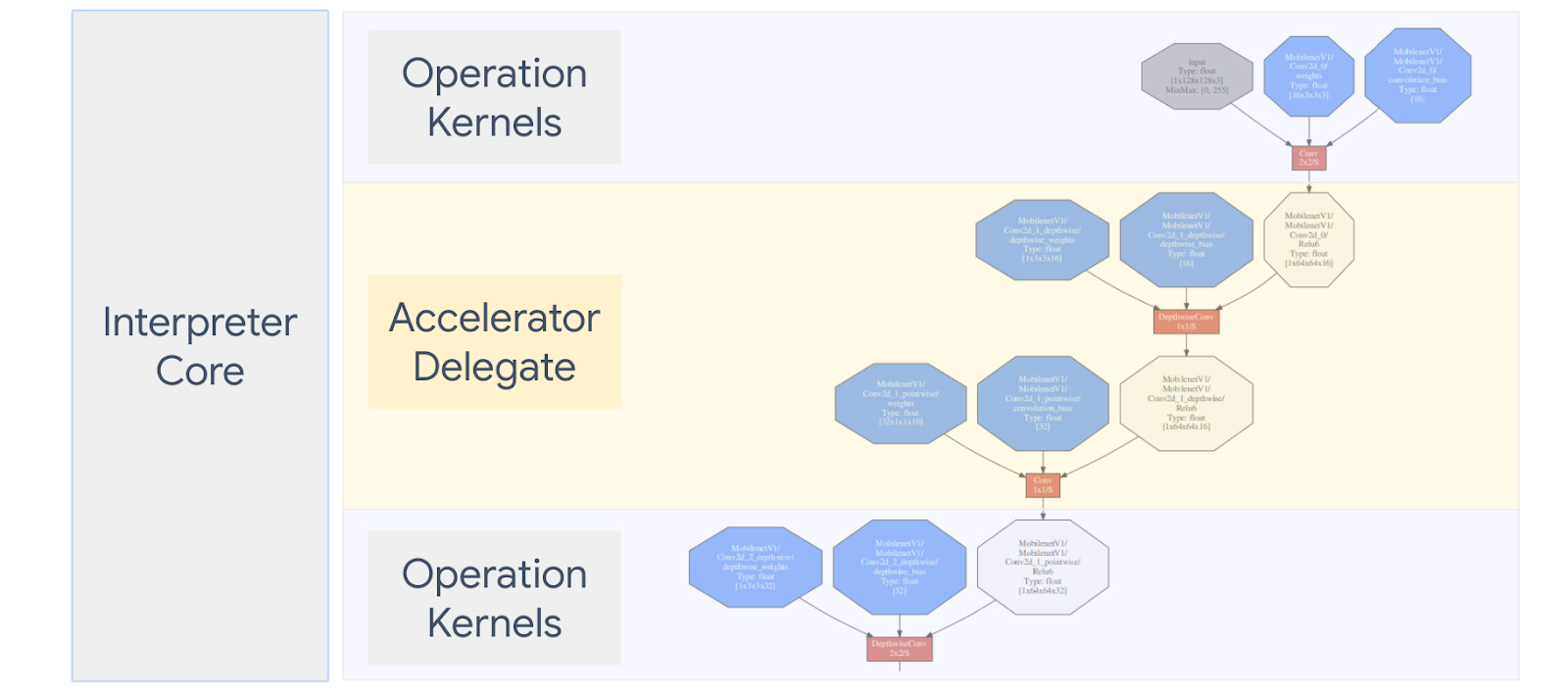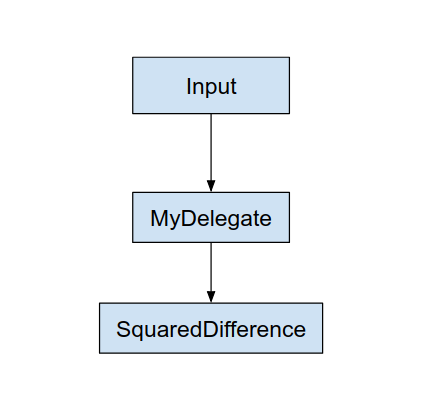TensorFlow Lite Delegate 可讓您在其他執行程式上執行模型 (部分或整個)。此機制可利用各種裝置端加速器進行推論,例如 GPU 或 Edge TPU (Tensor Processing Unit)。這可讓開發人員享有從預設的 TFLite 彈性的分離方法,以加快推論速度。
下圖為委派代表摘要說明,詳情請見後續章節。

何時該建立自訂委派代表?
TensorFlow Lite 有各種目標加速器 (例如 GPU、DSP 和 EdgeTPU) 委派項目。
在下列情況中,建立自己的委派代表非常實用:
- 您想要整合任何現有委派代表不支援的新機器學習推論引擎。
- 您有一個自訂硬體加速器,用來改善已知情境的執行階段。
- 您開發的 CPU 最佳化作業 (例如運算子融合) 可以加快特定模型的速度。
委派代表如何運作?
我們以簡單的模型圖為例,以及一個委派的「MyDelegate」以加快 Conv2D 和 Mean 作業的實作速度。

套用這個「MyDelegate」後,原始 TensorFlow Lite 圖表的更新方式如下:

TensorFlow Lite 根據以下兩項規則分割原始圖形時,會取得上述圖表:
- 委派可處理的特定作業會進入分區,但仍滿足作業之間原始運算工作流程的依附元件。
- 每個待委派的分區只包含不是由委派處理的輸入和輸出節點。
委派處理的每個分區都會由委派節點取代 (也可稱為委派核心),此種圖表會依照叫用呼叫評估分區。
視模型而定,最終圖形可能會有一或多個節點,而後者代表委派不支援部分運算。一般而言,您不會希望委派代表處理多個分區,因為每次您從委派代表切換至主要圖形時,將委派子圖表的結果傳遞至主要圖形,會因記憶體複製 (例如 GPU 到 CPU) 而產生負擔。這類負擔可能會抵銷效能提升,尤其是在出現大量記憶體副本時。
導入自己的自訂委派代表
我們建議您使用 SimpleDelegate API 新增委派代表。
如要建立新的委派,您必須實作 2 個介面,並為介面方法提供自己的實作項目。
1 - SimpleDelegateInterface
這個類別代表委派項目的功能、支援哪些作業,以及用於建立核心 (封裝委派圖表) 的工廠類別。詳情請參閱這個 C++ 標頭檔案中定義的介面。程式碼中的註解會詳細說明每個 API。
2 - SimpleDelegateKernelInterface
這個類別會封裝初始化 / 準備 / 執行委派分區的邏輯。
包含:(請參閱定義)
- Init(...):系統會呼叫一次以執行任何一次性初始化。
- Prepare(...):針對這個節點的每個不同執行個體呼叫 - 如果您有多個委派分區,就會發生此情況。通常您會想要在此執行記憶體配置,因為每次調整張量時,系統都會呼叫此方法。
- Invoke(...):系統會呼叫此方法進行推論。
範例
在此範例中,您將建立非常簡單的委派,以便僅支援 2 種類型的作業 (ADD) 和 (SUB),且僅支援 float32 張量。
// MyDelegate implements the interface of SimpleDelegateInterface.
// This holds the Delegate capabilities.
class MyDelegate : public SimpleDelegateInterface {
public:
bool IsNodeSupportedByDelegate(const TfLiteRegistration* registration,
const TfLiteNode* node,
TfLiteContext* context) const override {
// Only supports Add and Sub ops.
if (kTfLiteBuiltinAdd != registration->builtin_code &&
kTfLiteBuiltinSub != registration->builtin_code)
return false;
// This delegate only supports float32 types.
for (int i = 0; i < node->inputs->size; ++i) {
auto& tensor = context->tensors[node->inputs->data[i]];
if (tensor.type != kTfLiteFloat32) return false;
}
return true;
}
TfLiteStatus Initialize(TfLiteContext* context) override { return kTfLiteOk; }
const char* Name() const override {
static constexpr char kName[] = "MyDelegate";
return kName;
}
std::unique_ptr<SimpleDelegateKernelInterface> CreateDelegateKernelInterface()
override {
return std::make_unique<MyDelegateKernel>();
}
};
接著,請從 SimpleDelegateKernelInterface 繼承,建立自己的委派核心
// My delegate kernel.
class MyDelegateKernel : public SimpleDelegateKernelInterface {
public:
TfLiteStatus Init(TfLiteContext* context,
const TfLiteDelegateParams* params) override {
// Save index to all nodes which are part of this delegate.
inputs_.resize(params->nodes_to_replace->size);
outputs_.resize(params->nodes_to_replace->size);
builtin_code_.resize(params->nodes_to_replace->size);
for (int i = 0; i < params->nodes_to_replace->size; ++i) {
const int node_index = params->nodes_to_replace->data[i];
// Get this node information.
TfLiteNode* delegated_node = nullptr;
TfLiteRegistration* delegated_node_registration = nullptr;
TF_LITE_ENSURE_EQ(
context,
context->GetNodeAndRegistration(context, node_index, &delegated_node,
&delegated_node_registration),
kTfLiteOk);
inputs_[i].push_back(delegated_node->inputs->data[0]);
inputs_[i].push_back(delegated_node->inputs->data[1]);
outputs_[i].push_back(delegated_node->outputs->data[0]);
builtin_code_[i] = delegated_node_registration->builtin_code;
}
return kTfLiteOk;
}
TfLiteStatus Prepare(TfLiteContext* context, TfLiteNode* node) override {
return kTfLiteOk;
}
TfLiteStatus Eval(TfLiteContext* context, TfLiteNode* node) override {
// Evaluate the delegated graph.
// Here we loop over all the delegated nodes.
// We know that all the nodes are either ADD or SUB operations and the
// number of nodes equals ''inputs_.size()'' and inputs[i] is a list of
// tensor indices for inputs to node ''i'', while outputs_[i] is the list of
// outputs for node
// ''i''. Note, that it is intentional we have simple implementation as this
// is for demonstration.
for (int i = 0; i < inputs_.size(); ++i) {
// Get the node input tensors.
// Add/Sub operation accepts 2 inputs.
auto& input_tensor_1 = context->tensors[inputs_[i][0]];
auto& input_tensor_2 = context->tensors[inputs_[i][1]];
auto& output_tensor = context->tensors[outputs_[i][0]];
TF_LITE_ENSURE_EQ(
context,
ComputeResult(context, builtin_code_[i], &input_tensor_1,
&input_tensor_2, &output_tensor),
kTfLiteOk);
}
return kTfLiteOk;
}
private:
// Computes the result of addition of 'input_tensor_1' and 'input_tensor_2'
// and store the result in 'output_tensor'.
TfLiteStatus ComputeResult(TfLiteContext* context, int builtin_code,
const TfLiteTensor* input_tensor_1,
const TfLiteTensor* input_tensor_2,
TfLiteTensor* output_tensor) {
if (NumElements(input_tensor_1) != NumElements(input_tensor_2) ||
NumElements(input_tensor_1) != NumElements(output_tensor)) {
return kTfLiteDelegateError;
}
// This code assumes no activation, and no broadcasting needed (both inputs
// have the same size).
auto* input_1 = GetTensorData<float>(input_tensor_1);
auto* input_2 = GetTensorData<float>(input_tensor_2);
auto* output = GetTensorData<float>(output_tensor);
for (int i = 0; i < NumElements(input_tensor_1); ++i) {
if (builtin_code == kTfLiteBuiltinAdd)
output[i] = input_1[i] + input_2[i];
else
output[i] = input_1[i] - input_2[i];
}
return kTfLiteOk;
}
// Holds the indices of the input/output tensors.
// inputs_[i] is list of all input tensors to node at index 'i'.
// outputs_[i] is list of all output tensors to node at index 'i'.
std::vector<std::vector<int>> inputs_, outputs_;
// Holds the builtin code of the ops.
// builtin_code_[i] is the type of node at index 'i'
std::vector<int> builtin_code_;
};
對新的委派項目進行基準測試並評估
TFLite 提供一組工具,可讓您快速針對 TFLite 模型進行測試。
- 模型基準工具:此工具會使用 TFLite 模型,產生隨機輸入,然後重複執行模型以指定執行次數。並在結尾輸出匯總延遲統計資料。
- 推論差異工具:針對特定模型,這項工具會產生隨機的高斯文資料,並透過兩個不同的 TFLite 解譯器傳遞資料,一個執行單一執行緒 CPU 核心,另一個則使用使用者定義的規格進行傳遞。它會按元素測量每個解譯器之間的絕對差異。這項工具也有助於偵錯準確度問題。
- 此外,您也可以使用圖片分類和物件偵測等工作專用的評估工具。您可以在這裡找到這些工具
此外,TFLite 還有一組核心與運算單元測試,可用來重複使用更多涵蓋率資料來測試新的委派項目,並確保一般 TFLite 執行路徑未損毀。
如要重複為新委派代表執行 TFLite 測試及工具,您可以使用以下兩個選項中的任一項:
選擇最佳方法
這兩種方式都需要一些調整,詳情如下。不過,第一種方法會以靜態方式連結委派項目,且需要重新建構測試、基準化和評估工具。相對地,第二項動作會將委派項目設為共用程式庫,並需要您公開共用資料庫中建立/刪除方法。
因此,外部委派機制就能與 TFLite 預先建構的 Tensorflow Lite 工具二進位檔搭配使用。但這個做法較不明確,在自動化整合測試中可能比較難設定。使用委派註冊商做法更清楚瞭解所在位置。
方法 1:使用委派註冊商
委派註冊商會保存一份委派提供者清單,每個供應商都可以根據指令列標記輕鬆建立 TFLite 委派項目,因此對工具而言很方便。如要插入上述所有 Tensorflow Lite 工具的新委派項目,請先建立新的委派提供者,然後只對 BUILD 規則進行幾項變更。以下為這項整合程序的完整範例 (您可以在這裡找到程式碼)。
假設您擁有實作 SimpleDelegate API 的委派,以及用於建立/刪除此「虛擬」委派代表的臨時「C」 API,如下所示:
// Returns default options for DummyDelegate.
DummyDelegateOptions TfLiteDummyDelegateOptionsDefault();
// Creates a new delegate instance that need to be destroyed with
// `TfLiteDummyDelegateDelete` when delegate is no longer used by TFLite.
// When `options` is set to `nullptr`, the above default values are used:
TfLiteDelegate* TfLiteDummyDelegateCreate(const DummyDelegateOptions* options);
// Destroys a delegate created with `TfLiteDummyDelegateCreate` call.
void TfLiteDummyDelegateDelete(TfLiteDelegate* delegate);
如要整合「DummyDelegate」與 Benchmark Tool 和 Inference Tool,請按照下列方式定義 DelegateProvider:
class DummyDelegateProvider : public DelegateProvider {
public:
DummyDelegateProvider() {
default_params_.AddParam("use_dummy_delegate",
ToolParam::Create<bool>(false));
}
std::vector<Flag> CreateFlags(ToolParams* params) const final;
void LogParams(const ToolParams& params) const final;
TfLiteDelegatePtr CreateTfLiteDelegate(const ToolParams& params) const final;
std::string GetName() const final { return "DummyDelegate"; }
};
REGISTER_DELEGATE_PROVIDER(DummyDelegateProvider);
std::vector<Flag> DummyDelegateProvider::CreateFlags(ToolParams* params) const {
std::vector<Flag> flags = {CreateFlag<bool>("use_dummy_delegate", params,
"use the dummy delegate.")};
return flags;
}
void DummyDelegateProvider::LogParams(const ToolParams& params) const {
TFLITE_LOG(INFO) << "Use dummy test delegate : ["
<< params.Get<bool>("use_dummy_delegate") << "]";
}
TfLiteDelegatePtr DummyDelegateProvider::CreateTfLiteDelegate(
const ToolParams& params) const {
if (params.Get<bool>("use_dummy_delegate")) {
auto default_options = TfLiteDummyDelegateOptionsDefault();
return TfLiteDummyDelegateCreateUnique(&default_options);
}
return TfLiteDelegatePtr(nullptr, [](TfLiteDelegate*) {});
}
BUILD 規則定義相當重要,因為您需要確保程式庫一律連結,且不會由最佳化器捨棄。
#### The following are for using the dummy test delegate in TFLite tooling ####
cc_library(
name = "dummy_delegate_provider",
srcs = ["dummy_delegate_provider.cc"],
copts = tflite_copts(),
deps = [
":dummy_delegate",
"//tensorflow/lite/tools/delegates:delegate_provider_hdr",
],
alwayslink = 1, # This is required so the optimizer doesn't optimize the library away.
)
現在,請在 BUILD 檔案中新增這兩個包裝函式規則,即可建立基準工具/推論工具版本,以及其他可透過自己的委派執行的評估工具。
cc_binary(
name = "benchmark_model_plus_dummy_delegate",
copts = tflite_copts(),
linkopts = task_linkopts(),
deps = [
":dummy_delegate_provider",
"//tensorflow/lite/tools/benchmark:benchmark_model_main",
],
)
cc_binary(
name = "inference_diff_plus_dummy_delegate",
copts = tflite_copts(),
linkopts = task_linkopts(),
deps = [
":dummy_delegate_provider",
"//tensorflow/lite/tools/evaluation/tasks:task_executor_main",
"//tensorflow/lite/tools/evaluation/tasks/inference_diff:run_eval_lib",
],
)
cc_binary(
name = "imagenet_classification_eval_plus_dummy_delegate",
copts = tflite_copts(),
linkopts = task_linkopts(),
deps = [
":dummy_delegate_provider",
"//tensorflow/lite/tools/evaluation/tasks:task_executor_main",
"//tensorflow/lite/tools/evaluation/tasks/imagenet_image_classification:run_eval_lib",
],
)
cc_binary(
name = "coco_object_detection_eval_plus_dummy_delegate",
copts = tflite_copts(),
linkopts = task_linkopts(),
deps = [
":dummy_delegate_provider",
"//tensorflow/lite/tools/evaluation/tasks:task_executor_main",
"//tensorflow/lite/tools/evaluation/tasks/coco_object_detection:run_eval_lib",
],
)
您也可以按照這裡的說明,將這個委派提供者新增至 TFLite 核心測試。
選項 2:使用外部委派代表
在此替代方案中,您必須先建立外部委派轉接器 external_delegate_adaptor.cc,如下所示。請注意,與先前提到的方法 1 相比,這種做法較不合宜。
TfLiteDelegate* CreateDummyDelegateFromOptions(char** options_keys,
char** options_values,
size_t num_options) {
DummyDelegateOptions options = TfLiteDummyDelegateOptionsDefault();
// Parse key-values options to DummyDelegateOptions.
// You can achieve this by mimicking them as command-line flags.
std::unique_ptr<const char*> argv =
std::unique_ptr<const char*>(new const char*[num_options + 1]);
constexpr char kDummyDelegateParsing[] = "dummy_delegate_parsing";
argv.get()[0] = kDummyDelegateParsing;
std::vector<std::string> option_args;
option_args.reserve(num_options);
for (int i = 0; i < num_options; ++i) {
option_args.emplace_back("--");
option_args.rbegin()->append(options_keys[i]);
option_args.rbegin()->push_back('=');
option_args.rbegin()->append(options_values[i]);
argv.get()[i + 1] = option_args.rbegin()->c_str();
}
// Define command-line flags.
// ...
std::vector<tflite::Flag> flag_list = {
tflite::Flag::CreateFlag(...),
...,
tflite::Flag::CreateFlag(...),
};
int argc = num_options + 1;
if (!tflite::Flags::Parse(&argc, argv.get(), flag_list)) {
return nullptr;
}
return TfLiteDummyDelegateCreate(&options);
}
#ifdef __cplusplus
extern "C" {
#endif // __cplusplus
// Defines two symbols that need to be exported to use the TFLite external
// delegate. See tensorflow/lite/delegates/external for details.
TFL_CAPI_EXPORT TfLiteDelegate* tflite_plugin_create_delegate(
char** options_keys, char** options_values, size_t num_options,
void (*report_error)(const char*)) {
return tflite::tools::CreateDummyDelegateFromOptions(
options_keys, options_values, num_options);
}
TFL_CAPI_EXPORT void tflite_plugin_destroy_delegate(TfLiteDelegate* delegate) {
TfLiteDummyDelegateDelete(delegate);
}
#ifdef __cplusplus
}
#endif // __cplusplus
現在,建立對應的 BUILD 目標來建構動態程式庫,如下所示:
cc_binary(
name = "dummy_external_delegate.so",
srcs = [
"external_delegate_adaptor.cc",
],
linkshared = 1,
linkstatic = 1,
deps = [
":dummy_delegate",
"//tensorflow/lite/c:common",
"//tensorflow/lite/tools:command_line_flags",
"//tensorflow/lite/tools:logging",
],
)
建立這個外部委派 .so 檔案後,即可建構二進位檔,或使用預先建構的二進位檔與新的委派項目連結,前提是二進位檔必須與 external_delegate_provider 程式庫連結該程式庫 (如這裡所述)。注意:這個外部委派提供者已連結至現有的測試和工具二進位檔。
如要瞭解如何透過這個外部委派方法對虛擬委派項目進行基準測試,請參閱這裡的說明。您可以在前述的測試和評估工具中使用類似的指令。
值得注意的是,外部委派是 Tensorflow Lite Python 繫結中委派的對應 C++ 實作項目,如這裡所示。因此,在這裡建立的動態外部委派轉接器程式庫可直接與 Tensorflow Lite Python API 搭配使用。
資源
下載夜間預建 TFLite 工具二進位檔的連結
| OS | ARCH | BINARY_NAME |
| Linux | x86_64 | |
| 實驗組 | ||
| aarch64 | ||
| Android | 實驗組 | |
| aarch64 |

